You will not be surprised to hear we believe any time is a good time to think about fire safety but as we head towards Halloween and Bonfire Night it’s a particularly timely opportunity to consider children's fire safety.
The issue of children’s fire safety at this time of year was tragically highlighted in 2014 when TV presenter Claudia Winkleman’s then eight year old daughter suffered burns after her witch costume caught alight as a result of brushing against candles. Given the number of candles used at Halloween, the floaty style of the dress already presented a risk but that risk was increased by the consequences of the categorisation of her fancy dress costume as a toy. That had determined the flammability regulations that applied to the dress. But holding a toy and wearing a dress are very different scenarios in fire safety terms. If a child is holding a cuddly toy that ignites, it can be thrown down quickly. A child wearing a fancy dress outfit will be very quickly engulfed in flames and, as in the case of Claudia’s daughter, will suffer extensive burns as a result.
Since then, partly because of the high profile Watchdog campaign that followed, awareness of the risks has increased. Work is ongoing into the creation of a new standard to ensure fancy dress outfits meet more demanding flammability tests and two codes of practice have been developed for the testing and labelling of such clothes. But these are voluntary codes of practice so are not necessarily being applied by everyone. Parents still need to be very careful about the outfits their children are wearing.
Of course, it’s not only around Halloween that extra vigilance is needed. Bonfire night events are taking place. Generally, more candles are in use over the winter months. So it’s a good time to reflect on the importance of educating children about the danger fire poses and how they can help to keep themselves safe.
For example, discuss escape routes and what to do if they wake up in the middle of the night and there’s a fire. ROSPA offers some useful advice on points to consider. Teach children about the need to ‘Stop, Drop and Roll’ in the event of their clothes catching fire. Fire safety is an issue that needs to be reinforced as children get older. Explain why something they may perceive as ‘harmless’ messing around can have consequences; talk to them about the risks of deliberately starting a fire for ‘a bit of fun’ to impress their friends and how quickly it could get out of hand. With many older children regularly charging up appliances, explain the importance of doing it safely. That includes never leaving appliances charging overnight.
Children’s fire safety in schools and nurseries
Outside the home children spend most of their time at school or in other child care settings like nurseries. So as well as educating children about fire safety, it’s essential that we are protecting them from fire in those settings. Several fires, such as this one, have broken out in the school environment over the past few months alone. Even if the incident is relatively minor, it can still cause considerable disruption educationally, economically, socially and emotionally.
It’s essential that every school has procedures in place to reduce the likelihood of fire. That means conducting fire risk assessments to identify both the risks and the necessary steps to minimise those risks. Remember that any changes to a school’s premises need to be reflected in the risk assessments and they should be routinely reviewed to ensure they are kept up to date. Provide and maintain fire detection and alarm systems and all necessary firefighting equipment. Make sure there are clearly understood plans in place for dealing with incidents and that staff and pupils know what to do if there needs to be an emergency evacuation.
More information about the fire safety requirements for schools and similar settings is available on the Gov.UK website. If you are the person responsible for fire safety in your educational premises and could benefit from some specific advice then please contact us. The recently released codes of practice relating to children’s dressing up clothes can be found via these two links: Method of Test for the Flammability Safety of Children’s Dress-up and Flammability Labelling of Children’s Toy Dress-up and you can also visit The Children’s Burns Trust for updates and advice.
One complete fire and security solution
Need a local team to help with fire safety and security?
